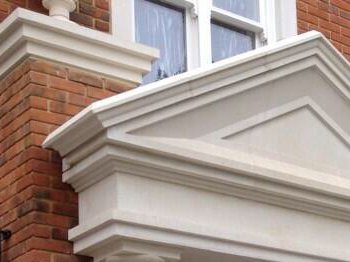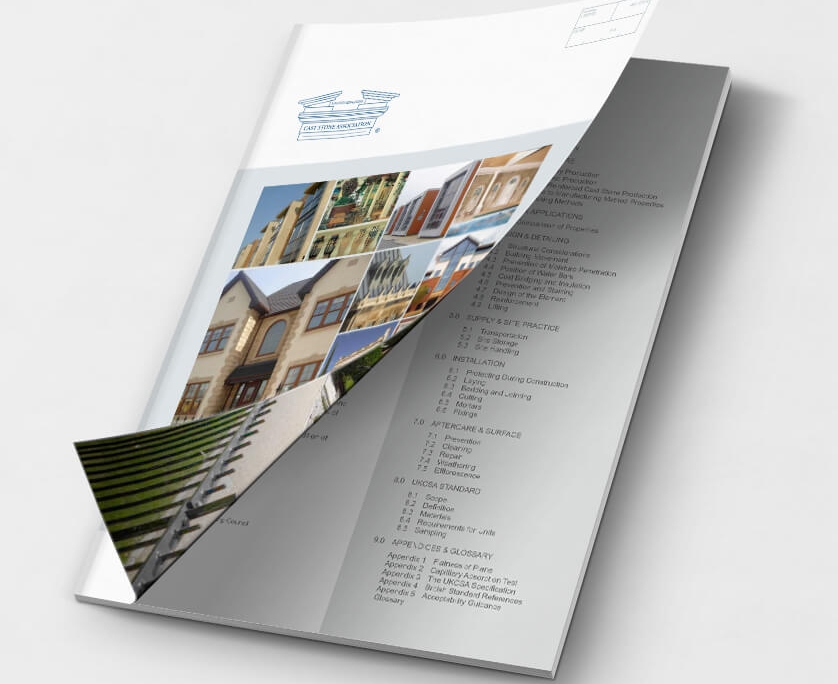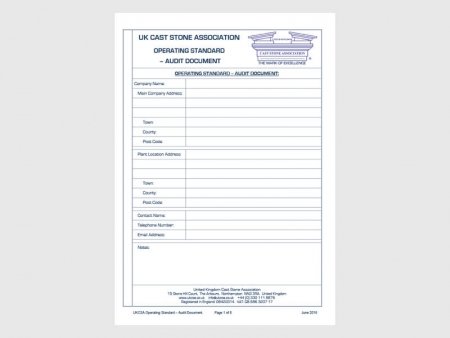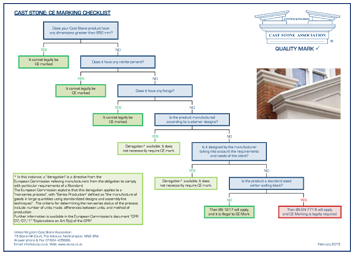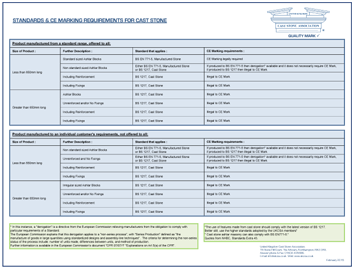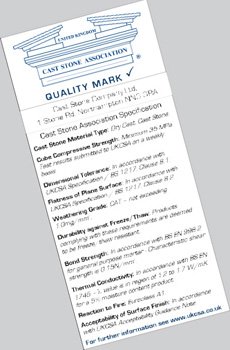The first British Standard for Cast Stone, BS 1217, was issued over seventy years ago in April 1945. Although the Standard for cast stone has been changed and considerably improved over the years, BS 1217 remains one of the longest standing British Standards which is still in existence today.
Towards the end of the 1980s, the increasing popularity in the use of cast stone was causing some concerns for the leading UK cast stone manufacturers at the time as new, and often inexperienced, users and manufacturers entered the industry for the first time. Many of these new entrant manufacturers were believed to be operating without adequate quality assurance or testing regimes and were often not working to the proper standards.
This concern regarding maintaining the quality and standards for cast stone in the UK lead directly to the formation of the UK Cast Stone Association in 1991. One of the first actions of the newly formed Association was to create a Technical Committee, specifically tasked to review, and improve, the standards and quality of cast stone being produced and used. By April 1993 the Technical Committee had produced and published the first UKCSA “Specifier and User Guide” for cast stone. The UKCSA “Specification for Cast Stone” was also being developed at that time, and was first published in June 1994, together with a number of extremely well received informative and standard setting guides covering most aspects of the manufacture and use of cast stone.
In the Summer of 2000, these individual specifications and guides were incorporated into one publication, the UKCSA “Technical Manual for Cast Stone”. The Technical Manual provides valuable guidance to all those wishing to capitalise on the attractive finishes, versatility and longevity of cast stone and covers all aspects of cast stone design, manufacture and use. It is regularly reviewed by the Association and fully revised updates were produced in 2004 and 2011. The Technical Manual is currently in the process of being reviewed and updated once again, and a new version of the Manual is expected to be published by the Association in the Summer of 2020. The UKCSA “Technical Manual for Cast Stone”, and before it the Association’s guidance and specification sheets, are generally accepted to be the construction industry’s standard reference document for all matters appertaining to cast stone, and the 2020 revision is eagerly awaited by all in the cast stone and construction industries.
Throughout its existence, the United Kingdom Cast Stone Association (UKCSA) has been actively involved in improving the national standards for cast stone, and over the years in conjunction with the BSI, and other industry bodies, this has resulted in the production of BS 1217:1997 and the current BS 1217:2008 versions of BS 1217 the British Standard for cast stone, as well as the subsequent review and re-confirmation of BS 1217:2008 in 2013. The UKCSA Technical Committee Members sit on a number of BSI committees, and in addition to the cast stone standards have recently been involved in the review, and re-issue in 2014, of the standards for both cills and copings.
The UK Cast Stone Association sets high standards for the cast stone industry, and membership of the Association by cast stone manufacturers is dependent on them achieving and continuously complying with the high standards, criteria and rules that the Association sets.
The UKCSA “Operating Standard – Audit Document” was first introduced in 1994, and it remains the standard against which all cast stone manufacturers are judged. Any new applicants for Full Membership of the Association have to pass a stringent examination and audit against the compulsory requirements of this document, and all cast stone manufacturing Full Members must demonstrate their continuing adherence to the UKCSA Standard and UKCSA Operating Standard – Audit Document as a condition of membership. This requirement includes the regular submission of cast stone test results to the Association and an annual declaration of conformance..
In the late 1990’s UKCSA part financed, and was heavily involved in, a two year research project into cast stone in conjunction with the University of Dundee, under the UK government’s Department of the Environment, Transport and the Regions (DETR) “Partners In Technology” (PiT) programme. After extensive investigation, experimentation and research, the University of Dundee determined that “All Cast Stone products, and particularly when waterproofed, were found to be highly resistant to carbonation. Efflorescence did not occur in any of the test samples and weathering in Cast Stone was similar to that in control natural stone. The data also suggests that dry-cast, Cast Stone is no less vulnerable to frost attack than natural stone.” The results also indicated “that the waterproofer used in all test samples is probably the most important characteristic controlling surface weathering performance.”
The University of Dundee, in the PiT Report Executive Summary went on to indicate that “the performance and durability of Cast Stone was directly related to its underlying “quality”, as determined by its strength, and was not reliant wholly upon the use of waterproofer. To ensure that Cast Stone supplied from UKCSA manufacturers was of a suitable “quality” the minimum compressive strength was recommended to be increased to 35 MPa (35 N/mm2 ) for contracts commencing January 1st 2000 onwards. However, given it’s importance to the final performance of the material, it was also felt that specifications should consider making the use of an integral waterproofer mandatory.” The Full Report also concludes that: “In general, all dry Cast Stone Samples tested weathered in a similar way to the natural stone from the results of the accelerated weathering test.”
UKCSA took up all of the recommendations arising from the PiT study and research and every cast stone manufacturing Member of the UK Cast Stone Association has to regularly demonstrate that they use an integral waterproofer in their cast stone mixes and that they achieve a minimum cube compressive strength of cast stone of 35 MPa, as a condition of their continuing membership of the Association. The enhanced UKCSA Member cast stone cube strength requirement is at least 40% above the British Standard and ensures strong cast stone with outstanding durability and site handling capabilities.
Not all cast stone manufacturers are the same. Most operate without adequate quality assurance or testing regimes and may not be working to the proper standards. In recognition of this the National House Building Council (NHBC) acknowledges cast stone in its own Standards and has stated “The use of features made from cast stone should comply with the latest version of BS1217. Better still, use the higher standards adopted by UKCSA members.” House builders should specify cast stone from an UKCSA Full Member to guarantee you are getting the best.
On 1st July 2013, CE marking became mandatory in the UK for certain construction products which are covered by harmonised European Standards, where the Annex Z of the relevant European Standard details the requirements for CE marking of the product. The UK standard for cast stone BS 1217, is a British Standard and it is therefore not possible to CE Mark to BS 1217, in fact it would be illegal to do so. At that time the UK Cast Stone Association produced a CE marking checklist and guidance documents to assist specifiers understand the complexities of the situation over the transition period and beyond.
However, the Association went much further than producing a simple checklist and in May 2013 introduced the UKCSA ‘Quality Mark’ to assist specifiers of cast stone. If users and specifiers of cast stone require further reassurance that the cast stone they are using is durable and produced to the highest standards, then they should look for the UKCSA ‘Quality Mark’ label on the cast stone.
The UKCSA Quality Mark Scheme covers a number of quality issues for cast stone, including strength, dimensional tolerance, weathering grade and resistance to freeze/thaw action. The “Quality Mark” label will only be available on cast stone which has been purchased from an UKCSA Member. The inclusion of a Quality Mark label on cast stone is the UKCSA manufacturing Member’s confirmation that the cast stone supplied complies with all of the Quality Mark Scheme requirements.
It is unknown what the next 25 years will bring for the cast stone industry in the UK and around the world, but manufacturers, specifiers and users alike can rest assured that UKCSA will be at the forefront, upholding standards in the manufacture, specification and use of cast stone as they have done for the past 25 years.
This article from Neil Sparrow, Director, UKCSA was included in the UKCSA 25th Anniversary Book.
Neil Sparrow has been on the UKCSA Technical Committee since 1996 and is the current Technical Committee Chair. Neil has continuously held Officer positions in the Association since 2000.

